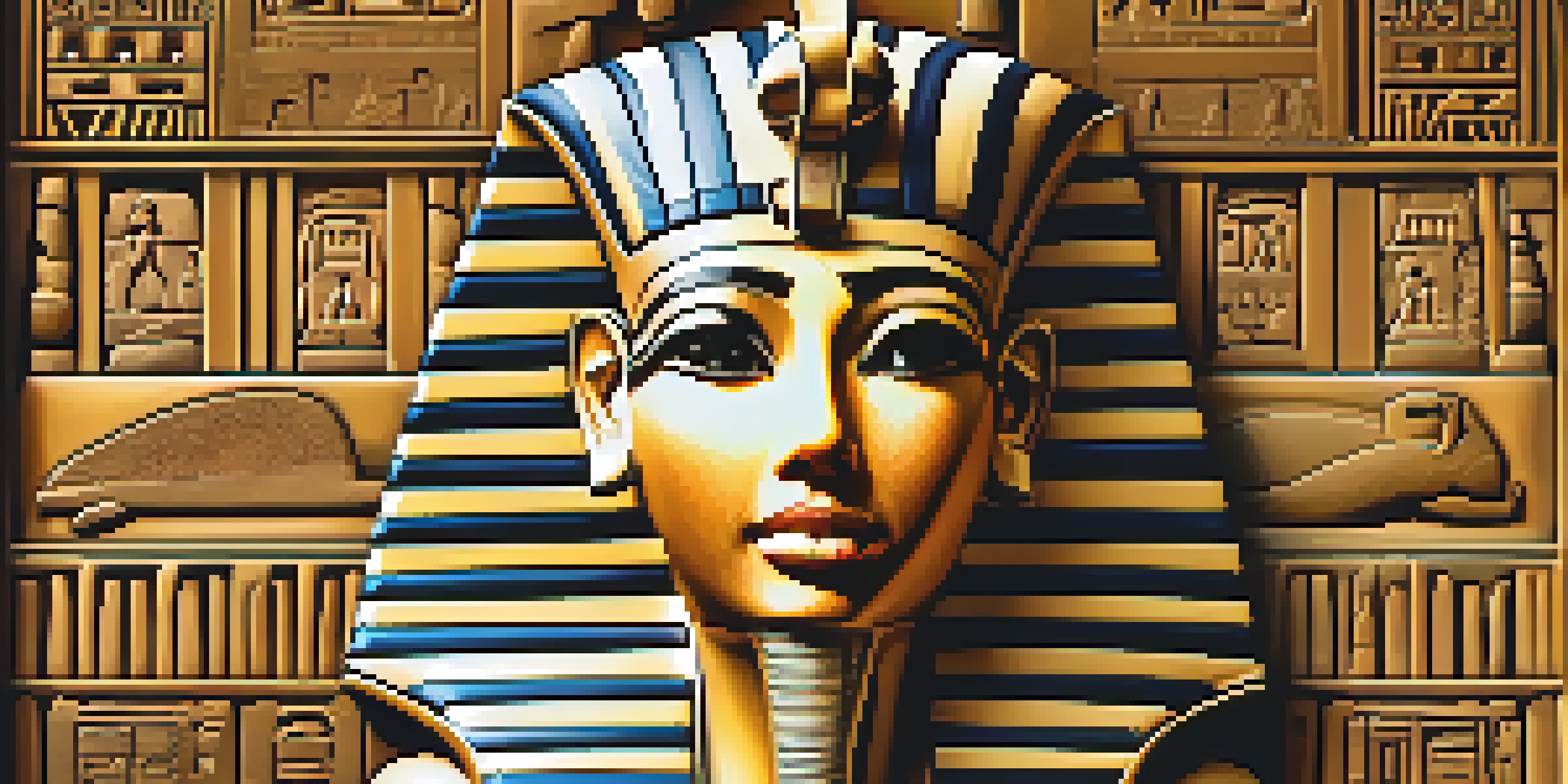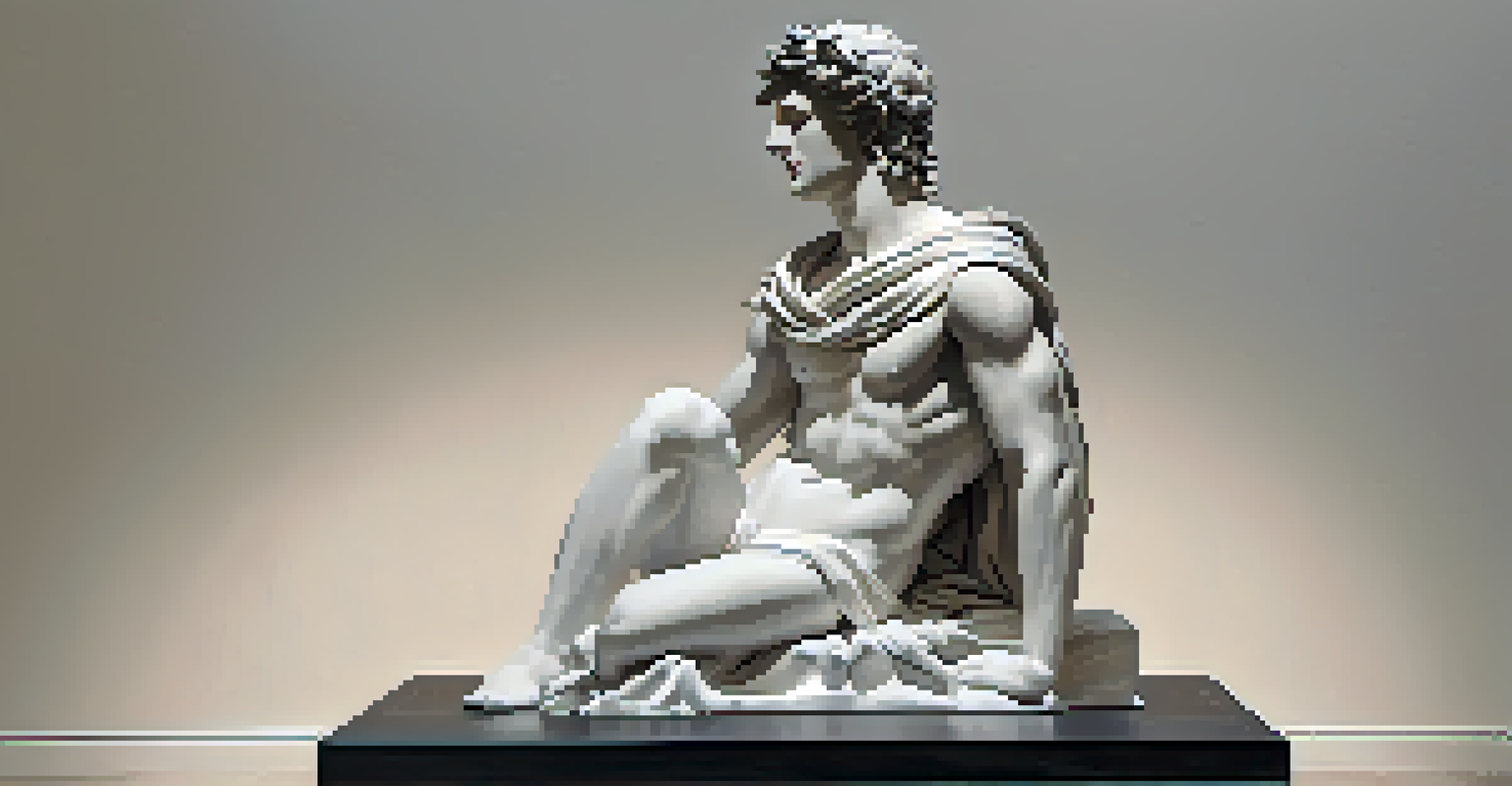Carving and Mythology: Stories Told Through Stone

The Intersection of Art and Mythology in Carving
Carving has long been a powerful medium where art and mythology intertwine. Through intricate designs and symbols, artists convey stories that reflect cultural beliefs and values. Each chisel mark holds a narrative, revealing humanity's connection to the divine and the mysteries of existence.
Art is the most beautiful of all lies.
For instance, ancient Egyptian carvings often depicted gods and pharaohs, illustrating the belief in the afterlife and the divine right to rule. These artworks served not just as decoration but as a bridge between the earthly and the spiritual realms. In this way, carvings become a visual language that speaks of the past.
As we explore various cultures, we see how carvings like totem poles in Indigenous cultures symbolize ancestral stories. This connection between craftsmanship and storytelling highlights the importance of preserving these narratives, ensuring they resonate with future generations.
Mythological Themes That Resonate in Stone
Certain mythological themes recur across different cultures, often represented through carvings. Heroes, creation myths, and the battle between good and evil are just a few examples. These universal stories find expression in stone, transcending time and geography.

Take the Greek mythology of Perseus, for example; many ancient sculptures depict his heroic feats, serving as both art and inspiration for future generations. Such carvings allow viewers to engage with the heroic journey, fostering a sense of connection to ancient values and ideals.
Carvings Connect Art and Mythology
Carvings serve as a powerful medium where intricate designs reflect cultural beliefs and tell stories that bridge the earthly and spiritual realms.
Moreover, the symbolism in these carvings helps keep the essence of these myths alive. As people encounter these artworks, they are invited to reflect on the lessons and morals embedded within, making the stone not just a material but a vessel of wisdom.
Cultural Significance of Carving in Myths
Carving plays a crucial role in conveying the cultural significance of myths. Each culture has its unique way of interpreting stories, often reflected in the style and technique of their carvings. This diversity enriches our understanding of humanity's shared narrative.
Myth is more individual and expresses life than does science.
For instance, the intricate carvings of Hindu deities found in temples serve not only as artistic expressions but as spiritual guides for worshippers. They encapsulate complex stories of creation, love, and duty, allowing devotees to connect deeply with their faith.
In this sense, carvings are much more than decorative art; they embody the history, beliefs, and values of a culture, allowing us to glimpse into their worldview. By studying these works, we gain insights into the human experience across different eras and societies.
The Techniques Behind Mythological Carvings
The techniques used in creating mythological carvings vary widely, reflecting the skills and tools available to artisans throughout history. From chiseling stone to intricate woodwork, each method carries its own charm and complexity. Understanding these techniques can deepen our appreciation for the artistry involved.
For example, the ancient Greeks mastered the art of marble sculpting, using tools like chisels and hammers to create lifelike representations of their gods. This dedication to detail and form brought their myths to life, allowing viewers to engage with the divine in tangible ways.
Universal Themes in Carvings
Mythological themes like heroism and creation myths are depicted in carvings across cultures, allowing viewers to engage with timeless narratives.
Similarly, Indigenous cultures often use natural materials like wood or bone to carve their mythological figures. These techniques not only showcase artistic talent but also a profound respect for nature, emphasizing the interconnectedness of all life as reflected in their stories.
Carving as a Medium for Storytelling
Carvings serve as a powerful storytelling medium, often conveying complex narratives through visual representations. Each element in a carving can symbolize different aspects of a story, allowing viewers to interpret and engage with it on multiple levels. This layered approach makes the carvings rich in meaning.
Consider the Mayan stelae, which feature detailed carvings that narrate the achievements of rulers and their divine connections. These stone monuments tell stories of power, warfare, and spirituality, inviting observers to reflect on their significance in the society's history.
Through this art form, the past is brought to life, allowing us to experience stories that may otherwise fade into obscurity. Carvings thus become a bridge between generations, preserving myths and tales for future exploration and understanding.
Modern Interpretations of Mythological Carvings
In today's world, contemporary artists continue to draw inspiration from mythological themes, reinterpreting them through modern carving techniques. This evolution of style reflects changing societal values while maintaining a connection to traditional narratives. It’s fascinating to see how these ancient stories adapt to contemporary contexts.
For instance, some modern sculptures incorporate mixed media, blending traditional carving with modern materials like glass or metal. This fusion creates fresh interpretations of age-old myths, inviting new audiences to engage with these timeless tales.
Preservation of Cultural Heritage
Efforts to preserve carvings are vital for maintaining cultural heritage, ensuring that their stories and artistry endure for future generations.
As artists experiment with form and content, they breathe new life into mythology, ensuring that these stories remain relevant. By connecting past and present, they showcase the enduring power of carving as a means of storytelling and cultural expression.
Preserving Carvings and Their Mythological Stories
Preserving carvings and their mythological stories is crucial for maintaining cultural heritage. As time passes, many carvings face deterioration due to environmental factors, neglect, or urban development. Efforts to conserve these artworks ensure their stories endure for future generations.
Organizations dedicated to heritage preservation often work tirelessly to restore and protect these carvings, employing techniques that balance modern technology with traditional methods. This collaboration is essential in keeping the history and narratives alive.

Moreover, public awareness and education about the significance of these carvings foster appreciation and respect for cultural heritage. By valuing these stories and the artistry behind them, we contribute to their preservation, ensuring they continue to inspire and teach long into the future.